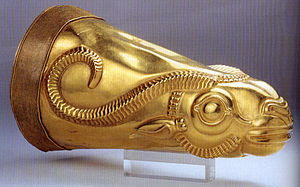Rhyton

Example: Golden rhyton from Iran's Achaemenid period. Excavated at Ecbatana. Kept at National Museum of Iran.
|
|
| Material | Ceramic, metal, horn, stone |
|---|---|
| Size | Cup-size for practical use, larger for ceremonial use, always in a roughly conical shape caused by a spout or a pseudo-spout at the bottom. |
| Writing | May be inscribed and otherwise decorated |
| Created | Prehistoric times through the present |
| Present location | Eurasia |
A rhyton (plural rhytons or, following the Greek plural, rhyta) is a roughly conical container from which fluids were intended to be drunk or to be poured in some ceremony such as libation, or merely at table. They are typically formed in the shape of an animal's head, and were produced over large areas of ancient Eurasia, especially from Persia to the Balkans. Many have an opening at the bottom through which the liquid fell; others did not, and were merely used as drinking cups, with the characteristic that they could not usually be set down on a surface without spilling their contents.
The English word originates in the ancient Greek word ῥυτόν (rhy̆tón or rhŭtón). The conical rhyton form has been known in the Aegean region since the Bronze Age, or the 2nd millennium BC. However, it was by no means confined to that region. Similar in form to, and perhaps originating from, the drinking horn, it has been widespread over Eurasia since prehistoric times.
Liddell and Scott give a standard derivation from Greek rhein, "to flow", which, according to Julius Pokorny, is from Indo-European *sreu-, "flow". As rhutos is "stream", the neuter, rhuton, would be some sort of object associated with pouring, which is equivalent to English pourer. Many vessels considered rhytons featured a wide mouth at the top and a hole through a conical constriction at the bottom from which the fluid ran. The idea is that one scooped wine or water from a storage vessel or similar source, held it up, unstoppered the hole with one's thumb, and let the fluid run into the mouth (or onto the ground in libation) in the same way that wine is drunk from a wineskin today.
Smith points out that this use is testified in classical paintings and accepts Athenaeus's etymology that it was named ἀπὸ τῆς ῥύσεως, "from the flowing". Smith also categorized the name as having been a recent form (in classical times) of a vessel formerly called the keras, "horn", in the sense of a drinking horn. The word rhyton is not present in what is known about Mycenaean Greek, the oldest form of Greek written in Linear B. However, the bull's head rhyton, of which many examples survive, is mentioned as ke-ra-a on tablet KN K 872, an inventory of vessels at Knossos; it is shown with the bull ideogram (*227VAS; also known as rhyton). Ventris and Chadwick restored the word as the adjective *kera(h)a, with a Mycenaean intervocalic h.
...
Wikipedia
